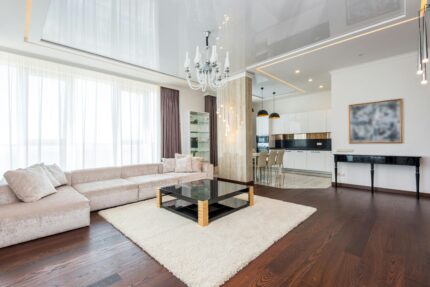The days are growing shorter and shorter, which means we’re more limited to natural light. This natural progression can create a unique challenge for homeowners — keeping your home feeling light and bright throughout the fall and winter! Fortunately, with some clever interior design tricks, you can maximize the available natural light we do get during the day and make your home feel more warm, open, and inviting all year long.
An interior designer in Viera, FL, recommends using a combination of mirrors, light paint colors, and strategic lighting placement to enhance natural light and create a bright and airy space even on the darkest winter days. Here’s how.
1. Leverage mirrors.
One of the most effective ways to maximize natural light is by strategically placing mirrors throughout your home. Mirrors reflect light and bounce it around a room, which instantly makes a space feel larger and brighter. To make the most of a full-length mirror, place it opposite a window to capture and reflect daylight into the room. If a full-length mirror isn’t an option, group smaller mirrors together. You’ll get a similar effect and a bonus decorative focal point! Mirrors also work well in hallways or darker corners of the home where natural light is minimal. A well-placed mirror can draw light from brighter areas into those darker spots to create an even distribution of brightness.
2. Choose light paint colors.
Instead of going dark with your wall color, choose lighter shades which reflect light better and make spaces feel open and airy. Dark hues tend to absorb light and make rooms feel smaller and more enclosed. That’s why you can lean toward whites, pale neutrals, or even light pastels in a high-gloss or semi-gloss finish for rooms that need a brightness boost during the darker months. When selecting a finish, glossy finishes reflect more light than matte ones, giving your walls a slight sheen that enhances brightness.
3. Strategically place lighting.
Rather than relying on a single overhead light, use layers of lighting to create a more even, natural glow throughout your space. To achieve this you can place a healthy mix of ambient, task, and accent lighting at multiple angles around the room. Start by ensuring you have strong ambient lighting, which is the overall illumination for the space. Ceiling fixtures, chandeliers, or recessed lighting work well for this. Opt for fixtures with multiple bulbs or light sources to distribute light more evenly. Next, incorporate task lighting where you need focused brightness. Finally, add accent lighting to brighten darker areas and create a layered effect.
4. Use sheer window treatments.
Heavy curtains or blinds can block light and make a room feel dim and enclosed, especially during the shorter days of fall and winter. Opt for sheer curtains or light, airy fabrics that let sunlight filter through. In rooms where privacy isn’t a concern, you might even choose to go without window treatments altogether. Leaving windows bare will truly maximize light.
5. Declutter and simplify what you have in the house.
To keep your home feeling bright and open, consider simplifying your décor and furniture layout. Removing unnecessary items from surfaces and decluttering shelves can allow light to flow more freely through the space. Opt for lighter, more minimalist furniture pieces and décor to create a sense of airiness.
Don’t let the lack of daylight hours get you down! Incorporating these design strategies will help you make the most of the natural light in your home as the days get shorter.




